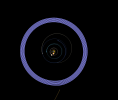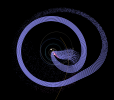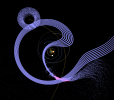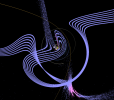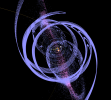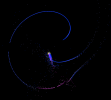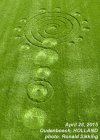You are using an out of date browser. It may not display this or other websites correctly.
You should upgrade or use an alternative browser.
You should upgrade or use an alternative browser.
Computational modelling of the companion star and its interaction with Sol
- Thread starter tohuwabohu
- Start date
tohuwabohu
Jedi Master
I have a master's degree in applied mechanical engineering and a doctorate in numerical methods. And now I am being pushed into assoc. prof. position. I am not keen on that either.
To tell you the truth I don't think that degrees are important. Having an academic degree doesn't make you a better person or any wiser on that matter. It doesn't help you to be more compassionate or more forthcoming. It's just few letters.
I have been studying my whole life but not to get some recognition or degrees but merely to understand. Since I was little I tried to understand how this reality works. I was doing calculations and simulations and I was reading a lot. And I am still doing it.
The truth is that you can achieve anything if you agree on putting some effort into it. If you are decided not to give up then there is no force that could stop you. You will advance step by step even if the steps are really small and even if you think the next step will be your last, you will go on. You will risk it all. And eventually you will achieve your goal even if it takes forever.
So this is what I am doing here. I simply use my mind to solve simple problems one at a time. If I don't know something I can always learn how to do it. This is a great time for those who wish to learn.
To tell you the truth I don't think that degrees are important. Having an academic degree doesn't make you a better person or any wiser on that matter. It doesn't help you to be more compassionate or more forthcoming. It's just few letters.
I have been studying my whole life but not to get some recognition or degrees but merely to understand. Since I was little I tried to understand how this reality works. I was doing calculations and simulations and I was reading a lot. And I am still doing it.
The truth is that you can achieve anything if you agree on putting some effort into it. If you are decided not to give up then there is no force that could stop you. You will advance step by step even if the steps are really small and even if you think the next step will be your last, you will go on. You will risk it all. And eventually you will achieve your goal even if it takes forever.
So this is what I am doing here. I simply use my mind to solve simple problems one at a time. If I don't know something I can always learn how to do it. This is a great time for those who wish to learn.
Hi tohuwabohu,
I agree with your assessment on academic degrees and academia on the whole. The main thing is not to be entrapped by the academic mindset and become a zombie so to speak. However, if you have a chance to have a associate professor position, you might take it to ensure an economic income. Teaching is very time-consuming. I've given a few lectures for graduate students lately (and one in the next few weeks) and it's not easy at all. However, I think that with an optimal organization of time and effort, one can manage to leave enough for more interesting knowledge-related activities. Degrees do not make one a better person, but allows one to put meat on the table and have free access to research papers in the system as it still exists today. Tomorrow will be another story. OSIT.
I agree with your assessment on academic degrees and academia on the whole. The main thing is not to be entrapped by the academic mindset and become a zombie so to speak. However, if you have a chance to have a associate professor position, you might take it to ensure an economic income. Teaching is very time-consuming. I've given a few lectures for graduate students lately (and one in the next few weeks) and it's not easy at all. However, I think that with an optimal organization of time and effort, one can manage to leave enough for more interesting knowledge-related activities. Degrees do not make one a better person, but allows one to put meat on the table and have free access to research papers in the system as it still exists today. Tomorrow will be another story. OSIT.
HiThere
The Living Force
I have checked in on this thread a couple of times the last months, but have been inconsiderate in not writing to express my appreciation for your work, tohuwabohu. It is truly impressive and is helping me to develop a firmer impression of the upcoming events. So thank you :)
Hello Tohuwabohu, I agree with hithere, your work is certainly stretching my neurons.
I don't have any academic qualifications, but here's my two bob's worth.
I have seen it somewhere, not in Cass, that the residue from meteoric impact with the atmosphere, such as that during meteor showers, which happen regularly, takes approximately two months to settle out of the atmosphere.
During this time they create storms and monsoons as the atmospheric moisture attaches itself to the particles.
Given this, there would be some reduction in atmospheric dust loading after each event, as the atmosphere cleans itself.
The main worry would have to be extinction style events occurring with impact of the larger bolides, which actually impact with the Earth.
I don't have any academic qualifications, but here's my two bob's worth.
I have seen it somewhere, not in Cass, that the residue from meteoric impact with the atmosphere, such as that during meteor showers, which happen regularly, takes approximately two months to settle out of the atmosphere.
During this time they create storms and monsoons as the atmospheric moisture attaches itself to the particles.
Given this, there would be some reduction in atmospheric dust loading after each event, as the atmosphere cleans itself.
The main worry would have to be extinction style events occurring with impact of the larger bolides, which actually impact with the Earth.
kanader
Jedi
This is just amazing !
the amount of data, the dedication, the openness of how your provide these information's... is just mind blowing !
thank you soo much for your effort Tohuwabohu, and to all of you who are contributing to this thread.
Well done my Friends ! Really appreciate it !
the amount of data, the dedication, the openness of how your provide these information's... is just mind blowing !

thank you soo much for your effort Tohuwabohu, and to all of you who are contributing to this thread.
Well done my Friends ! Really appreciate it !
tohuwabohu
Jedi Master
Thank you guys for your support, I appreciate it very much. Well step by step the informations keep adding little by little so we will see where it will lead. I am just afraid that the associate professor position will left me with less time on my hands. Moreover teaching is not only time consuming but also exhausting. But the bright side is I can support others some more as mkrnhr said. So what can I do, I will just enjoy the ride and see where it takes me.
MusicMan I agree with you, moreover I think that the inner solar system is loaded with dust which is then collected as the Earth sweeps through it on her orbital journey. But of course I cannot prove it because we are working with very limited data here. Perhaps the amount of dust in the atmosphere even seasonally oscillates.
I am just trying to understand what is going on in some general terms, and if the companion throws a lot of rocks into the inner solar system then the dust is integral part of it. We can enjoy the fact that one can get to same results via different ways. So perhaps some dust expert is scratching his head as he is looking at his dust samples and thinks that something is not right. :)
MusicMan I agree with you, moreover I think that the inner solar system is loaded with dust which is then collected as the Earth sweeps through it on her orbital journey. But of course I cannot prove it because we are working with very limited data here. Perhaps the amount of dust in the atmosphere even seasonally oscillates.
I am just trying to understand what is going on in some general terms, and if the companion throws a lot of rocks into the inner solar system then the dust is integral part of it. We can enjoy the fact that one can get to same results via different ways. So perhaps some dust expert is scratching his head as he is looking at his dust samples and thinks that something is not right. :)
tohuwabohu
Jedi Master
I've made some progress. But it is only partial success. The 26 million years simulation took one month to complete and unfortunately the companion star did not return to the point of origin.
The problem is somewhat related to what was encountered at the start when I was investigating the orbit of the companion star which was interacting only with the sun. I found that the aphelion distance does not mesh with the orbital period. I had to increase the mass of the sun by 50% so that the parameters are met. Well and I took the initial velocity of the sun and companion star directly from this two body system only to find after one month that it is not correct either.
I have found the hard way that if I wish to accurately model the system then there have to be all the planets because with perihelion being so close to the sun the planets influence the companion star. So the aphelion distance does depend also on the position of the planets during the closest passage.
It is similar to what happens when you drop a ball on a vibrating plate. The vibrations should be vertical. The ball bounces irregularly because sometimes its movement is damped and other times its movement is augmented.
Because the companion star has such long orbital period even the slightest change in its state vector will change the orbital parameters considerably.
It is also possible that the concept of gravity as we know it is not correct. We take gravity to be a function of mass. But what if gravity is an expression of some underlying energy. That would mean that the gravity of the companion star and of other bodies could change in time to some extent. That would alter their gravitational pull and also their orbits.
The problem is somewhat related to what was encountered at the start when I was investigating the orbit of the companion star which was interacting only with the sun. I found that the aphelion distance does not mesh with the orbital period. I had to increase the mass of the sun by 50% so that the parameters are met. Well and I took the initial velocity of the sun and companion star directly from this two body system only to find after one month that it is not correct either.
I have found the hard way that if I wish to accurately model the system then there have to be all the planets because with perihelion being so close to the sun the planets influence the companion star. So the aphelion distance does depend also on the position of the planets during the closest passage.
It is similar to what happens when you drop a ball on a vibrating plate. The vibrations should be vertical. The ball bounces irregularly because sometimes its movement is damped and other times its movement is augmented.
Because the companion star has such long orbital period even the slightest change in its state vector will change the orbital parameters considerably.
It is also possible that the concept of gravity as we know it is not correct. We take gravity to be a function of mass. But what if gravity is an expression of some underlying energy. That would mean that the gravity of the companion star and of other bodies could change in time to some extent. That would alter their gravitational pull and also their orbits.
tohuwabohu
Jedi Master
The partial success that I mentioned in previous post is related to experiment of the cometary showers formation. I was thinking that the bodies in the primary wave might be the cause but the simulation had shown that this is not the case. These bodies had so much energy that they were ejected from the solar system and did not return.
On the other hand the destabilized tail that is formed behind the companion acted as a seed of the cometary shower. I made a simulation of what happens if the companion crosses some high density rings that are approximately 80 AU distant. The distance is heliocentric distance. So there was 800,000 bodies accumulated in seven rings with totally stable circular orbits. Then the companion approaches and the ring starts to deform due to the present gravity well (Fig. 39).
After the rings are broken you can see in Fig. 40 the primary wave on its way out beyond the rings. The pink color means the bodies were in interaction with the inner solar system. If you see a red colored body then it was a close encounter with earth. Close means approximately 10 lunar distances. In the figure you can also see that the destabilized tail region is pulled toward sun and starts to interact with the inner solar system.
In Fig. 41 it can be seen that the companion intersect the rings also on its way out and the primary wave from this interaction is directed outwards. Also notice that the destabilized tail region from the first interaction of the companion with the rings returned to the position from which it started (where the companion intersected the rings), mind the pink colored bodies. This is why I call it seed. It looks like if the bodies were springing from the point of intersection and this will be truly the aphelion.
Fig. 42 shows that the destabilized tail region from the second intersection is also starting to interact with the inner solar system and meanwhile the first destabilized tail bodies are starting to be pulled towards the sun.
In Fig. 43 you can see the result after the system was evolved for 1500 years. One can notice that after the companion passage there are clearly two cometary showers formed. One is formed during the way in and the other one during the way out as the companion intersects the rings. Also notice that the bodies do not clump together but are almost evenly spread along the pink colored elliptical area. With time the aphelion distance of the bodies starts to change due to the interaction with the planets. Some bodies are ejected form their stable orbits, some are drawn closer on tighter orbits and for some the aphelion distance increases.
The planets are doing great job in cleaning the solar system of debris. Most of the bodies in the plane of ecliptic and close to it will not survive long enough to be present after 26 million years. But for bodies with perpendicular orbits the probability is high that they will survive.
On the other hand the destabilized tail that is formed behind the companion acted as a seed of the cometary shower. I made a simulation of what happens if the companion crosses some high density rings that are approximately 80 AU distant. The distance is heliocentric distance. So there was 800,000 bodies accumulated in seven rings with totally stable circular orbits. Then the companion approaches and the ring starts to deform due to the present gravity well (Fig. 39).
After the rings are broken you can see in Fig. 40 the primary wave on its way out beyond the rings. The pink color means the bodies were in interaction with the inner solar system. If you see a red colored body then it was a close encounter with earth. Close means approximately 10 lunar distances. In the figure you can also see that the destabilized tail region is pulled toward sun and starts to interact with the inner solar system.
In Fig. 41 it can be seen that the companion intersect the rings also on its way out and the primary wave from this interaction is directed outwards. Also notice that the destabilized tail region from the first interaction of the companion with the rings returned to the position from which it started (where the companion intersected the rings), mind the pink colored bodies. This is why I call it seed. It looks like if the bodies were springing from the point of intersection and this will be truly the aphelion.
Fig. 42 shows that the destabilized tail region from the second intersection is also starting to interact with the inner solar system and meanwhile the first destabilized tail bodies are starting to be pulled towards the sun.
In Fig. 43 you can see the result after the system was evolved for 1500 years. One can notice that after the companion passage there are clearly two cometary showers formed. One is formed during the way in and the other one during the way out as the companion intersects the rings. Also notice that the bodies do not clump together but are almost evenly spread along the pink colored elliptical area. With time the aphelion distance of the bodies starts to change due to the interaction with the planets. Some bodies are ejected form their stable orbits, some are drawn closer on tighter orbits and for some the aphelion distance increases.
The planets are doing great job in cleaning the solar system of debris. Most of the bodies in the plane of ecliptic and close to it will not survive long enough to be present after 26 million years. But for bodies with perpendicular orbits the probability is high that they will survive.
Attachments
tohuwabohu
Jedi Master
Thank you Laurelayn that would be great.
You have remainded me of what happened one year ago. It's a funny story. I was just hacking on the simulation program and tested it and one evening I just ran a simulation and went away from the computer and after I came back there was a big "C" across the screen. You can imagine how surprised I was. I remember I was thinking 'how nice it's C as Cassiopaea'. I even saved the picture so here it is.
You have remainded me of what happened one year ago. It's a funny story. I was just hacking on the simulation program and tested it and one evening I just ran a simulation and went away from the computer and after I came back there was a big "C" across the screen. You can imagine how surprised I was. I remember I was thinking 'how nice it's C as Cassiopaea'. I even saved the picture so here it is.
Attachments
Laurelayn
Jedi
Wow. and that is pretty awesome!
The convergence here of people "thinking on the same page" has really caused me to pay attention to my own thoughts on a regular basis. so many times my thinking goes along certain lines and I come to the forum and there it is, many, if not most times I find a post by someone, sometimes on the other side of the planet, that is sharing what could be my own thought lines (for lack of a better term)
My mathematical strengths are in 3d stuff, I am a cabinetmaker/artisan type, but, the way you share your processes and the ways you have calculated the things in your posts here bring me closer to not understanding, but, a perception that maybe there is a mathematical way to gain knowledge and understanding of everything around us. its kind of exciting... :D
The convergence here of people "thinking on the same page" has really caused me to pay attention to my own thoughts on a regular basis. so many times my thinking goes along certain lines and I come to the forum and there it is, many, if not most times I find a post by someone, sometimes on the other side of the planet, that is sharing what could be my own thought lines (for lack of a better term)
My mathematical strengths are in 3d stuff, I am a cabinetmaker/artisan type, but, the way you share your processes and the ways you have calculated the things in your posts here bring me closer to not understanding, but, a perception that maybe there is a mathematical way to gain knowledge and understanding of everything around us. its kind of exciting... :D
Attachments
tohuwabohu,
Thank you for the update. The images are stunning! One month to run the simulation really takes dedication. It sounds like there are really so many variables that it is very difficult to even do the simulation. The broken rings is really an interesting development. It sounds like there are so many "possibilities" going on at the same time that the result as it gets to us is still "open".
It reminds me of these cosmic remarks by the Cs:
Session 31 July 2002
I have seen what happens when you discharge a capacitor and it can be quite shocking you might say. ;)
Thank you for the update. The images are stunning! One month to run the simulation really takes dedication. It sounds like there are really so many variables that it is very difficult to even do the simulation. The broken rings is really an interesting development. It sounds like there are so many "possibilities" going on at the same time that the result as it gets to us is still "open".
It reminds me of these cosmic remarks by the Cs:
Session 31 July 2002
Q: (Brainwave) So all his theory about this Light Warrior thing may have some kind of credibility?
A: In a sense, but not precisely in the way thought. Groups of people represent energy portals in cosmic rather than global terms.
Q: (S) Does that mean that we are seeing him as a force that was a representative...
A: Light warriors are "connectors" on a cosmic level.
Q: (L) Connectors between what and what?
A: Transducers of energy of transition rather like capacitors!
Q: (L) What's a capacitor? (M) It's an electrical way of collecting and dumping a flowing charge; a way of accumulating charge and releasing it later in a sudden burst of energy. You can send enormously strong pulses from capacitors by putting in small amounts of energy over a long period of time. They used to be called accumulators. (Perceval) What transition?
A: Transition of your sector of space/time.
I have seen what happens when you discharge a capacitor and it can be quite shocking you might say. ;)
tohuwabohu
Jedi Master
Laurelayn said:Wow. and that is pretty awesome!
The convergence here of people "thinking on the same page" has really caused me to pay attention to my own thoughts on a regular basis. so many times my thinking goes along certain lines and I come to the forum and there it is, many, if not most times I find a post by someone, sometimes on the other side of the planet, that is sharing what could be my own thought lines (for lack of a better term)
This is amazing you just said what I only felt but couldn't express it in words. I am much better with numbers you know. I am convinced more and more that different people with different skills can meet and complement each other and they can create some complete unit. Just as you said people which are thinking along the same lines but can see things from different perspectives. They are like perpendicular, like the three axes in 3d. You have greatly enriched this thread by expressing what I could not and thus adding new perspective and for me also new understanding which was hidden until now.
The crop circle is fairly recent and really looks like solar system. There is also this spiral that is emanating from one of the bodies kinda like if it would spiral inward. Perhaps it's an indication that there is something outside the solar system. Or maybe it's an atom. :D
Well I will continue with the simulations I will not just give up yet. I am interested myself what is at the end of this journey. And this just doesn't feel like I am finished.
tohuwabohu
Jedi Master
goyacobol, you are right the results are inconclusive. I will try to do some more tests from the mechanical point of view but then I think it may be necessary to implement also the electrical component.
The purely mechanical view surely is limited so it might happen I will run out of options soon.
The purely mechanical view surely is limited so it might happen I will run out of options soon.

